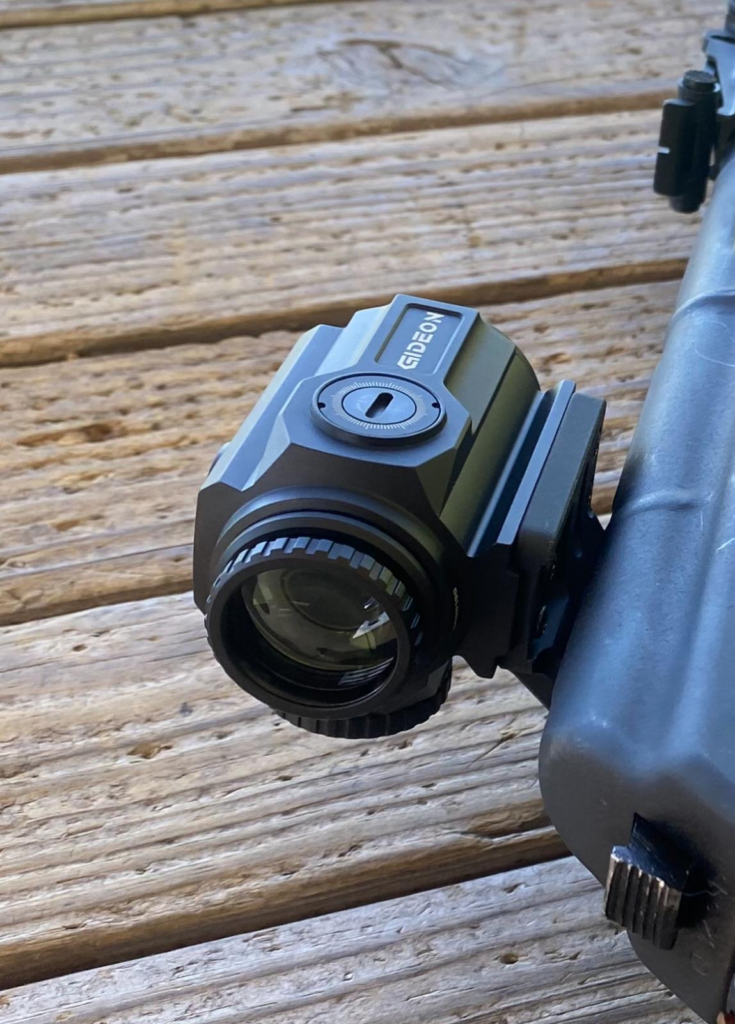I recently dipped my toe into the world of prismatic sights with Gideon Optic’s new Advocate. I included the Advocate in my review of a Romanian-made WASR-10 7.62x39mm AK with the help of an RS Regulate mount. This was my first time spending any amount of actual trigger time with any prismatic sight, so my inner optics-nerd was very excited.
Prismatic Optic Background Info
Fundamentally, prismatic optics work exactly like traditional riflescopes: they capture and handle light in order to magnify an image to the shooter’s eye. Riflescopes accomplish this by passing light through stacks of lenses whereas prismatic optics use a series of strategically placed glass prisms to do the same. The different arrangement of prisms in these types of optics allows them to be more compact as well; both their magnifications and prisms are fixed in place, and their placement is proportional to magnification.

Non-magnified prismatic sights, especially compact units, seem to be increasing in popularity as alternatives to the traditional reflex (red-dot) sight. All red-dot sights work by emitting a small beam of LED light that is caught and reflected off a coated lens back to the shooter’s eye while allowing all other light to pass through. Reflex sights are simple and effective; but one of their drawbacks for many is that dots appear starburst or blurry for those with astigmatisms. Because prismatic optics employ etched reticles the way traditional riflescopes and LPVOs do, the blurry-starburst effect is non-existent. There’s no emitted beam to reflect.
The etched reticles are always visible, whether the illumination is on or off like with any other scope. In the case of a 1x optic like the Gideon Advocate, it helps to think of it as a “zoomless” mini-scope that takes the place of a red-dot. Like any other scope, the Advocate still has objective and ocular lenses and utilizes a diopter to adjust the prescription (focus). This also means that there’s an eyebox involved when looking through the optic, unlike with red-dot sights.
Gideon Advocate Overview

The Gideon Advocate is a fairly compact 1 x 20mm “micro” prismatic sight built with roof prisms. Its external housing is made from 6061 aluminum and has an IPX7 waterproof rating. The etched and illuminated reticle consists of a simple upright triangle that’s 12 MOA tall and approximately 14 MOA wide that sits inside a segmented circle. Similarly, its click values are straight forward, with each click moving either windage or elevation 1 MOA at 100 yards. The Advocate uses the standard Aimpoint T1 mounting footprint, so finding mounts and adapters isn’t difficult.
The Gideon Advocate’s illumination array is fueled by a single CR 2032 battery and offers eight different daytime illumination settings with two that work under night vision. The system is motion activated (shake-awake) and shuts down after four minutes of inactivity. The unit has an adjustable eyepiece in order to set the correct focus. Eye relief is approximately 3.5 inches and I found the Advocate’s eyebox to be fairly reasonable. Field of view is listed on Gideon’s website as 79 feet at one hundred yards.
While shooting it, I didn’t think about the specific FOV but it felt like most any other 1x optic in this regard. Parallax is minimal to the point where it’s not relevant, and whatever amount of distortion present is another non-issue given this optic’s use case. Gideon Optics also includes by default a Picatinny compatible rail mount as convenience, and this is something else that’s hard to complain about for its cost.
The Gideon Advocate On the Range
So far, my only experience with the Gideon Advocate has been in the review of the Century Arms WASR-10 AK which consisted of 220 rounds with shots fired at distances of 15, 25, 50 and 100 yards at various targets like IPSC paper targets and NRA B-8s. Regrettably, I didn’t have access to steel targets at further intermediate distances like 200-300 yards. I’d still love for a chance to try shooting the Gideon Advocate that way.
The Advocate’s 12 MOA tall triangular reticle favors CQB distances. For example, at 25 yards, when aiming at an NRA B-8 target, all three corners of the triangle will touch the edges of the 5.5 inch B-8’ black scoring area. Keep in mind that this bullseye at 100 yards would measure 5.5 MOA. Again, the reticle is “coarse” for fast shots. On Gideon’s official IG account, one will find the Advocate mounted on a Beretta 1301 shotgun, which makes a lot of sense for a 12-gauge weapon. Similarly, this optic would be right at home on a subgun, PPC or any other firearm set up for quick, close range shots.


On A Kalashnikov
In the case of my Kalashnikov review, I zeroed the optic at 100 yards with the upper tip of the triangle. This adjustment resulted in having impacts dead-on at 15-yards with the same upper tip of the reticle. At 25-yards with the sight picture I just described (the reticle being imposed over the entire black portion of the B-8) all shots were landing comfortably inside the center of the B-8. At both 50 and 100 yards, this same zero gave me impacts just underneath the upper tip (with a little variation).
Distance Challenges
At 100 yards, it’s still easy to aim and strike any “full-size” target. However, due to the inherent design of the reticle, precision takes a backseat. Even shooting from a bench/rested position, I struggled to consistently hit B-8 targets or even the 8.5×11″ sheet of paper they’re printed on. Groups looked more like patterns, with too much lateral deviation–more than is reasonable even for an AK shooting 7.62×39 ammo. This wasn’t an AK problem as much as it was an aiming reference issue. Without magnification, it’s simply challenging to precisely align the top of the triangular tip with respect to both windage and elevation. Furthermore not having any other reference to help align, center or bracket the reticle also makes it challenging because its easy to swing too wide on both the X & Y axes.
Without the magnification, it’s like shooting at a target with a front sight or bead only. It wouldn’t matter at close distance but at further distance the lack of a rear sight as a reference becomes a hindrance. Keep in mind that this specific critique only concerns shooting smaller targets, say 6″ or less at distance. There is no doubt the optic will still help a shooter get hits on A/C-zone sized (or bigger) targets–but the challenging in precision is something to be aware of. This isn’t to say it can’t be done, but it will take more work.
Further Thoughts
For its price, the quality of the construction and glass found in the unit is hard to complain about. I can’t honestly speak as to what extent the Gideon Advocate will hold up long-term because I haven’t had a chance to run it hard for a longer amount of time. With its current price, it’s quite competitive in its optics peer-group. When zeroing this optic, I was pleasantly surprised to see that the clicks were sharper and crisper than I expected.
I had an issue seeing double in a way that doesn’t happen with LPVOs or riflescopes, so I shot the Gideon Advocate with one eye closed 99% of the time. I’m unsure whether this double-vision is my own issue or something inherent to prismatic sights (which I’m new to). I yet can’t say, but in the meantime I’ve been shooting with one eye closed. Twisting the diopter did nothing to solve the issue, and the further the target, the further the images on my double vision sit apart.
CQB-wise the Advocate’s reticle works just fine, but I’m still on the fence on about that 12×14 MOA triangle due to how coarse it can be at distance, especially for firearms chambered in intermediate or larger cartridges.
As an upstart optics company, Gideon Optics has really been getting in gear with their product launches over the past few months. They started out with pistol dots only and are now selling LPVOs and prismatic sights. For a smaller upstart in the affordable optics tier, the company is starting to get really aggressive in their offerings. With regards to a non-magnified prismatic sight, the new Gideon Advocate represents another affordable option.





